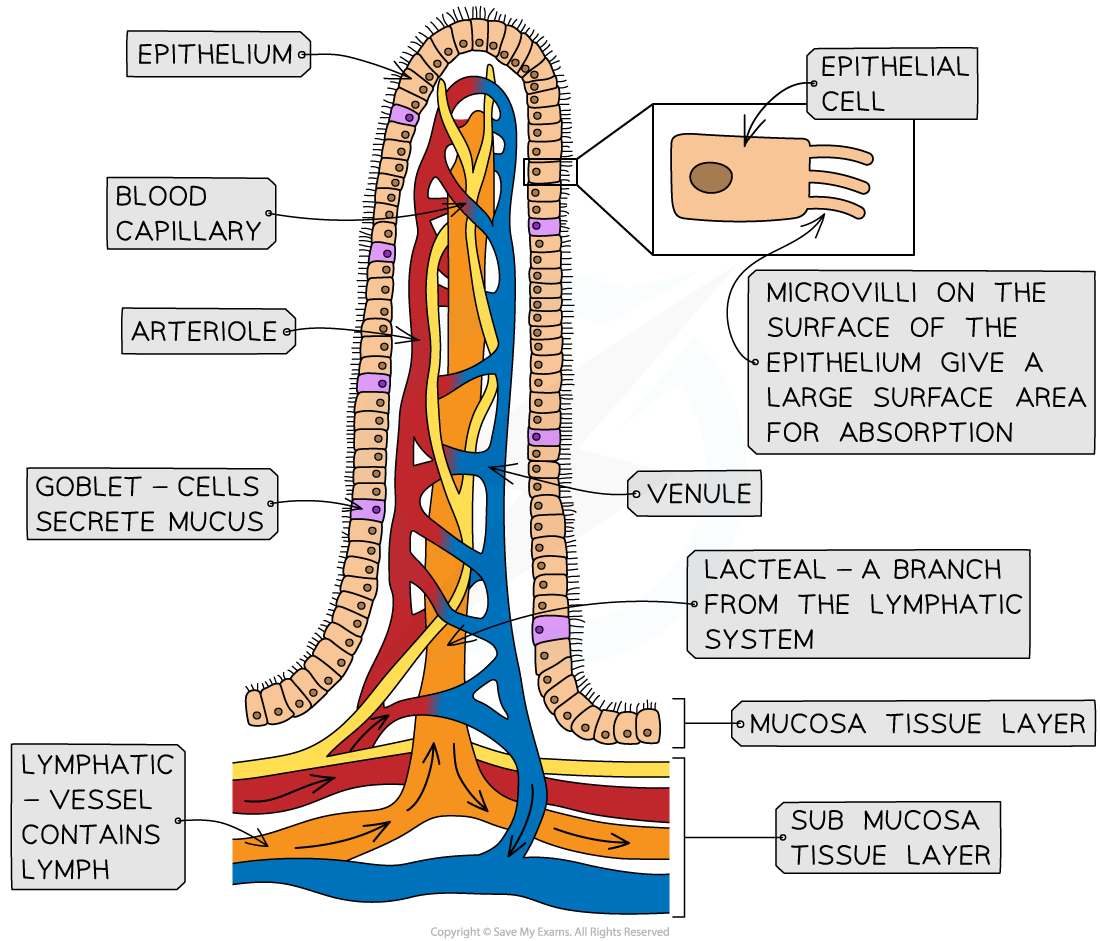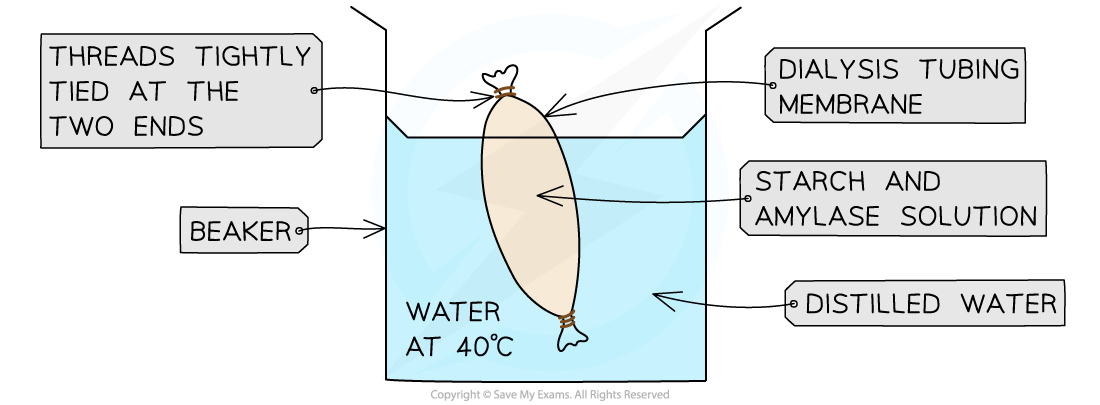Villi: Increasing the Surface Area
- The ileum (the second section of the small intestine) is adapted for absorption
- It is very long
- It has a highly folded surface
- It has millions of villi (singular villus)
- Finger like projections on the internal intestinal walls
- The epithelium of each villus is covered in microvilli
- Foldings of the cell surface membrane of the epithelial cells

A villus is covered in microvilli which provide a huge surface area to maximise absorption in the small intestine
Villi: Absorption
- Absorption takes place in the ileum
- Absorption is the movement of digested food molecules, vitamins and mineral ions from the digestive system into the blood and lymph
- This includes the following products of digestion:
- Simple monosaccharides e.g. glucose, fructose, galactose
- Amino acids
- Fatty acids, monoglycerides and glycerol
- Nucleotide bases
- And the following additional substances:
- Mineral ions e.g. calcium, potassium, sodium
- Vitamins e.g. vitamin C
- Water is absorbed in both the small intestine and the colon, but most absorption of water occurs in the small intestine
Absorption of unwanted substances
- The epithelium provides a barrier to prevent absorption of some harmful substances
- However, some unwanted substances can still pass into the blood. This includes:
- Some harmless chemicals found in food colourings and flavours; these are removed by the kidney and lost in the urine
- Small numbers of bacteria - these are engulfed and digested by phagocytes in the blood
- Some other harmful substances - these are removed from the blood and broken down by the liver
Dialysis Tubing Experiment
Investigating the absorption of the products of digestion using dialysis tubing
- Dialysis tubing (sometimes referred to as Visking tubing) is a non-living, partially permeable membrane made from cellulose
- It is sometimes used to model the process of digestion and absorption that occurs in the small intestine
- Pores in the membrane are small enough to prevent the passage of large molecules (such as starch and sucrose) but allow smaller molecules (such as glucose) to pass through by diffusion

Dialysis tubing can be used to model the epithelium of the small intestine
Method
- Fill a section of dialysis tubing (tube 1) with a mixture of:
- 1 ml 1% amylase solution
- 10 ml 1% starch solution
- Tie up the tubing tightly with a piece of thread
- Suspend the tubing in a beaker of water for a set period of time at 40°C
- Take samples from the liquid outside the dialysis tubing at regular intervals and test for the presence of starch and glucose
- Iodine is used to test for the presence of starch. A blue-black colour is produced in the presence of starch
- Benedict's reagent is used to test for the presence of glucose. An orange-red precipitate is formed in the presence of glucose when Benedict's solution is added and the solution is heated to 90°C or above
- Repeat the same method in a second dialysis tube (tube 2) with a mixture of:
- 1 ml distilled water
- 10 ml 1% starch solution
Results
- Tube 1:
- The amylase present inside the dialysis tube breaks down starch into glucose
- Over time the concentration of glucose in the liquid outside the dialysis tube should increase as more starch is digested
- Glucose is small enough to diffuse across the partially permeable membrane
- The amount of precipitate produced from the Benedict's reagent test will increase over time
- No starch should be found in the liquid outside the dialysis tubing
- Starch molecules are too large to diffuse across the partially permeable membrane
- The iodine test will be negative
- Tube 2:
- Without amylase present, the starch is not broken down into glucose
- The glucose tests done on the water outside the dialysis tube show no glucose is present as no precipitate is formed
- Starch molecules are too large to diffuse across the partially permeable membrane, so the iodine test will be negative
Limitations
- This test is qualitative, so does not show the rate of enzyme activity
- The rate of digestion can be investigated quantitatively by using the semi-quantitative Benedict’s test
- Comparisons can be made at time intervals using a set of colour standards (known glucose concentrations) or a colorimeter to give a quantitative set of results
- A graph could be drawn showing how the rate of diffusion changes with the concentration gradient between the inside and outside of the tubing
- The rate of digestion can be investigated quantitatively by using the semi-quantitative Benedict’s test
Other investigations using dialysis tubing
- Dialysis tubing can also be used to investigate other features of digestion such as
- The effects of different factors on the rate of digestive enzyme activity
- Investigating the effect of pH
- Eg. multiple dialysis tubings are set up containing solutions of starch and amylase kept at different pH levels using buffer solutions
- Investigating the effect of temperature
- Eg. multiple dialysis tubings are set up in water baths of different temperatures
- Investigating the effect of pH
- The effect of membrane permeability on absorption
- E.g. using cola to show how some smaller particles (glucose) can diffuse through the partially permeable membrane whilst larger molecules (food colouring) cannot
- The effects of different factors on the rate of digestive enzyme activity
Using Models to Represent Real Life
NOS: Use models as representations of the real world; dialysis tubing can be used to model absorption in the intestine
- Models are often used to study living systems which may be too complicated to observe in reality and achieve meaningful results
- There may be too many factors influencing a system at any one time
- Scientists may have access to specialist equipment that enables them to carry out computer based models e.g. the Dynamic Gastric Model, used to analyse factors influencing digestion
- It is also possible to model some systems using much simpler equipment, such as the dialysis tubing model from the experiment above
- The dialysis tubing membrane is used to represent the membrane of the small intestine:
- It is an accurate model because both are partially permeable so smaller particles can pass through the membrane whilst larger particles cannot; the membrane therefore allows the passive movement of solutes in diffusion, and water molecules in osmosis
- However, the small intestine has a much larger surface area due to the presence of villi
- Additionally, dialysis tubing is limited in the processes it can mirror and cannot show active transport
- Distilled water is used to represent blood:
- This is a good model because both have an initially low solute concentration
- However, the distilled water does not flow in the same way as blood and so does not maintain the concentration gradient as blood does
- The dialysis tubing membrane is used to represent the membrane of the small intestine:
